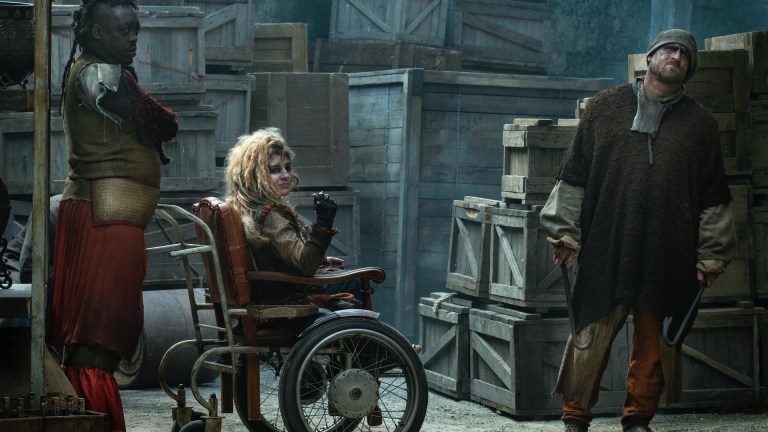The Watch Episodes 1 and 2 Review
BBC America's loose Discworld adaptation, The Watch, introduces its world (to varying success) with “A Near Vimes Experience" and "Ook."

This The Watch review contains spoilers.
The Watch Episodes 1 and 2
Anyone who has read science fiction and fantasy novels in the last 40 years has at least heard of Terry Pratchett’s “Discworld,” and it’s with some trepidation and cautious optimism that fans of the books have anticipated the new BBC adaptation, The Watch, which focuses on some of the best-loved characters from the 41-book series. What readers should know is that the series is very much an adaptation, and while there are plenty of moments that are true to the originals, and add details from various books, don’t go in expecting something as faithful as Bridgerton. In fact, don’t even go in expecting something as faithful as Peter Jackson’s Lord of the Rings.
The Watch isn’t the books—it’s becoming its own thing, and it may end up being more fun because of that.
If you’ve never read a Discworld book (let alone one of the “City Watch” subseries of novels), you’re in for a trip. The Watch’s Discworld—primarily the urban sprawl of Ankh-Morpork—is a chaotic, messy place, dominated by vying guilds and ruled by Vetinari, the Patrician, who has only little use for the City Watch. When Vetinari orders Vimes to investigate the theft of a book from the Unseen University library, everyone’s first response is to dismiss the concern: why would even a Watch as useless as Ankh-Morpork’s go after a stolen book? But the tome holds more danger than anyone realized, and Captain Sam Vimes and his team are embroiled in a mystery that involves dragons, drug deals, murdered alchemists and imps, a man who should have been dead the last twenty years, and a plot to burn the city to the ground.
Despite standing on its own two feet, this adaptation excels when making direct nods to the book series (or at least it’s particularly thrilling to a fan like myself). The title of the first episode, “A Near Vimes Experience,” is a direct quote from the books—Death, who is a character (and is delightfully portrayed by Wendell Pierce, whose complaints about people interrupting him while he’s working allow Death some levity), frames the first episode by having Vimes’s life flash before his eyes. It’s the flashbacks, both to twenty years earlier and to the events of the previous week, that present viewers with the story.
In those earliest moments, viewers discover that Sam Vimes (Richard Dormer) became a member of the City Watch as an undercover member of a gang, run by criminal Carcer Dun (Samuel Adewunmi), to free the other gang members who had been arrested. Instead, inspired by Captain Keel of the City Watch, Vimes chases after Carcer to arrest him, and Carcer falls from Unseen University’s roof into flashes of lightning and, presumably, dies. But in the present, Vimes thinks he sees Carcer at a (psychedelic) tavern, and he begins investigating out of the feeling that he’s seen a ghost—and that somehow Carcer is involved in a greater plot.
Discworld fans will recognize bits of that story (some drawn from Night Watch) and see how it doesn’t quite line up with the series. In The Watch, Carcer is a more complex character, a gang leader who’d been trying to care for his own crew (though in questionable ways), and—by the end of the second episode—a driven man with a mission. The first two episodes also borrow heavily from the plot—and some of the characterizations—in Guards! Guards! a secret organization steals a book to summon a dragon. Carcer provides the face for that shadowy organization, as well. Lady Sybil Ramkin (Lara Rossi), who becomes involved in the investigation in the book, insinuates herself into the investigation in The Watch as well and, already a force to be reckoned with, is an essential member of the team by the end of the second episode.
Also drawing from Guards! Guards!, The Watch follows the arrival of Carrot—a 6’6” human raised by dwarves, who is as honest and forthright as the noblest traditional fantasy hero—as a new recruit to the City Watch. Whereas the Watch has been rendered ineffective by the deals that the various guilds have with the Patrician (the Thieves’ Guild has a quota of legally allowed thievery, and so long as the Assassins’ Guild has the proper paperwork for their inhumations, any murder they commit is legal), Carrot is a true believer in justice that serves the people and keeps them safe. He joins the cynical members of the Watch who have mostly given up on doing meaningful work: Sergeant Detritus, a Troll; Angua, a werewolf; and Cheery, a forensic expert and female dwarf. All three are misfits, who’d have had no place in Ankh-Morpork had Vimes not offered them jobs. (Detritus meets an untimely death at the beginning of episode 2 “Ook,” which is disconcerting not just because we’ve only just met the character, but because his body is made of rock—which, in the books, is practically impenetrable, and would have kept him safe from the crossbow bolts that, in The Watch, killed him.)
Cheery, played to great effect by Jo Eaton-Kent, is presented as a tall dwarf (Eaton-Kent is not as tall as Adam Hugill’s Carrot, who raises an eye at both her size and her gender). Eaton-Kent is a genderfluid actor, and the show does a brilliant job dismissing gender expectations in just a few lines:
ANGUA: Cheery’s our forensic officer. Nothing she doesn’t know about potions and powders.
CARROT: She?
ANGUA: She.
CHERRY: Me.
From there, it’s simply accepted, and Cheery is who she is: a tall dwarf who’s remarkably gifted with fantasy-world forensics. She does a tremendous job with fingerprinting, collecting clues from crime scenes, and bringing Vimes back to himself after a drinking binge with her dosage of near-magical Klatchian Coffee.
Hugill plays the earnest Carrot with all the gravitas the character is due, and his straight-laced performance gives the other actors plenty to work off of. While Angua (Marama Corlett) differs the most from her literary inspiration, the portrayal of a werewolf who gets to decide who sees her and when, and how she lets others in, is well done. Corlett is also filmed to appear tiny compared to the other members of the team, which plays against her deadliness with a crossbow (and fang and fur, all of which is played off-screen).
Dormer’s (who played Beric Dondarrion on Game of Thrones) Vimes has one of the most expressive faces on television, and his physical acting is both impressive and true to the early origins of the character. This is a Vimes who is downtrodden, who believes in people and in justice but can’t figure out how to make a difference, who believes in a good pair of boots, and who depends on the bottle to get him through his day. There’s tremendous room for growth in his character, and Dormer plays him as a man who feels as deeply as he can before he has to drown out his emotions with a stiff drink. Rossi’s Ramkin is a fantastic foil for this Vimes; she’s sure of herself (although clearly she’s been hurt in the past). She’s a vigilante, determined to change the streets by converting one criminal at a time. She trains a pocket sized dragon, has rows of weaponry and armor (all of which she can use expertly), and wields her prestige and family fortune like a force of nature.
All of the casting is quite well done, and gender-swapped characters like Vetinari and Throat—who here is not only gender-swapped by excellently performed by Ruth Madeley, who uses a wheelchair, adding another interesting layer to that unlicensed criminal and source of information—are a delight. (IMDd shows Madeley listed for three episodes, and I’m looking forward to seeing more of Throat.) The diversity and inclusion make Ankh-Morpork feel as cosmopolitan as I’d expect from a big city, and it counters the criticisms many viewers rightly have over fantasy shows that are too white.
This all isn’t to say that the show hits its stride off the bat. While Ankh-Morpork’s population creates a sense of big city fantasy, the mix of technology levels hasn’t quite yet gelled, even after Archchancellor Ridcully (James Fleet) justifies the “keeping the lights on” as a magical effect rather than electricity. The hand-crossbows, carried around like guns (and Vimes wearing what looks like a gun belt) feel off. The fantasy-punk vibe is a strange one, and while it may yet work for the series, it’s different enough from what viewers might expect that it takes getting used to.
Add to that psychedelic graffiti, jarring scene changes, and quick camera angles, and it can be hard to keep up with the show. It’s the kind of visual stimulus that makes you feel like you need to see it twice before you’ve really caught what’s going on, which can be a bad sign for a just-starting series. The actors also speak quickly, in a variety of accents, which reinforces the multicultural feel of the city but made me wish the screeners had the option to turn on subtitles so I could keep up.
Some of the effects (the dragons in particular) are very well done, but others feel determined by budget rather than effectiveness. The style of filming and effects reminds me quite a lot of Neil Gaiman’s Neverwhere (also BBC, 1996) in that way; there’s a sense of keeping the effects gritty and real by using materials rather than digital effects, but the other side of that coin is that they can feel under-done. The Librarian—who in the books is a wizard who mistakenly transformed into a orangutan, but who refuses to allow the wizards to change him back because his form is so effective—is, in The Watch, hidden under a cloak, hiding the form that he so gleefully embraces in the series, and his facial makeup looks plastic and not orangutan-like at all. (On the other hand, The Watch’s depiction of Unseen University Library itself is absolutely gorgeous and a place where I could imagine spending hours or days exploring.)
If viewers can embrace the frenetic pacing and mixed-era visuals, there’s a lot to love here. Most of my worst objections (why are the wizards, especially the Archchancellor, not wearing hats, for Pratchett’s sake?) are due to details I was expecting rather than internal problems with the show.
And that may be the thing The Watch has the hardest time overcoming; by its nature, this adaptation is most likely to draw people who are already fans of Pratchett, and they’re also going to be the hardest audience to win over.
